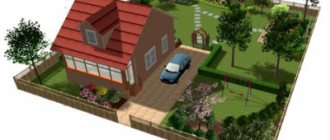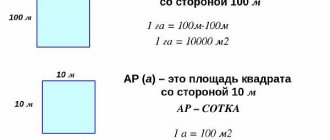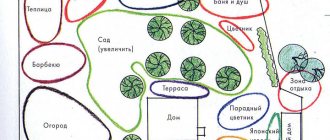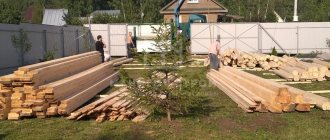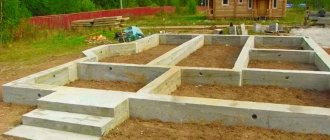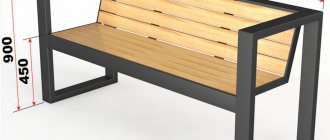What is one hundred square meters of land?
This value has been found on the territory of our state for about a hundred years. It was introduced by the Bolsheviks immediately after the October events 1 century ago, when they came to power.
Perimeter
First of all, a weaving is a piece of land equal to 10x10 meters (in length and width). In quadrature it will be equal to 100 m2. If you ask yourself the question – one hundred square meters is how many square meters, then you can immediately answer it – 100 square meters.
If the question arises, how much is one hundred square meters of land, then the answer will be the same. It’s easy to remember: 1 hundred square meters is 100 square meters (100 m2). The same is true for larger areas. Thinking about the problem, a plot of land of 10 acres is how many meters, you can calculate and say - 10 acres is a plot of land 100 meters long and 10 meters wide.
The mathematics in this regard is quite simple.
Simple calculations will allow you to quickly convert the dimensions of length and width into the required values.
Where did the hundreds come from - let’s eliminate the confusion in concepts
In pre-revolutionary Russia, the classic measure of land was the tithe, which was divided into fixed units of measurement. For example, “melon garden” with a plot size of 80x10 m² (fathoms in the old days).
With the help of tithes, they even measured the area for mowing grass, making a simple calculation: a tithe of land - 10 stacks of hay. This unit of measurement was used until the revolution of 1917, a year after which the country began a gradual transition to the metric system of measures.
The concept of tithe was replaced by an ar - a square plot of land 10x10 m, which corresponds to 100 m². The new measure significantly eased the complexity of calculations, since the total area became easy to measure by the number of 10x10 m squares included in a specific area.
Summer cottage plot of 6 acres
Sotki, as a name, appeared back in the Soviet years, when dachas began to appear en masse, the area of which was 4-6 ares. “Sotka” literally means the numeral “one hundred”; it is easy to pronounce and does not cause confusion with the number of meters.
Thus, the popular definition confidently took its place in the language of Soviet citizens and has successfully taken root in modern times. However, questions like “how many square meters are in one hundred square meters” are still relevant.
It is especially difficult to understand the issue for those who have never faced the need to measure the area of a plot in order to understand its real size (for example, when buying/selling land).
You will be surprised how simple everything is: 1 hectare is 100 square meters or are of land, and an area of 10 hectares corresponds to 10x100 m². Knowing the square footage, you can now easily plan construction - how many squares can you build a house on, how much to allocate for other buildings, and how much will go to the strawberry patch.
At the same time, large territories (rural purposes, forest lease, etc.) are measured in hectares. Along with square meters, cadastral engineers use this unit of measurement when calculating the area of objects. Therefore, the skill of converting meters into hundreds and hectares will be useful to every literate person.
Units of measurement of land area
There is another unit of measurement for large plots of land - an acre. In our country, it is used to determine the area of agricultural land. One acre of land is 4046.86 m² or 40.47 acres.
Weaving is how many meters
Today, in a garden or vegetable garden, when checking with a summer resident about the parameters of a plot, you can hear a quantity that is incomprehensible and rarely encountered by a city dweller. It is not taught in schools. In physics lessons, she is not given anything to classify, since she is not from the “C” system. Why, not even all summer residents know this parameter for sure.
Plot of 30 acres
To understand the size of a plot of land, the owner of a summer house or garden plot can, for convenience, convert the values into ares or meters. Knowing the boundaries of the plot, in order to convert the dimensions of the land into hundreds, you need to find its area in square meters.
How to find out how many acres there are on a plot
We found out how many meters in an arena, so from theory to practice. To convert this value into square meters, remember the capacity of 1 hundred square meters - this is 100 m². To visually represent the area of land in one hundred square meters, we measure it in meters and get the required number.
Suppose you measured the territory with a tape measure and found out the distance on each side: the length of the site was 65 meters and the width was 40 meters. To calculate the total area, all that remains is to multiply the resulting numbers: 65x40 = 2600 square meters.
Now we convert meters to hundreds. To do this, divide the land area in meters by the number of meters in 1 hundred parts: 2600/100 = 26 hundred parts. We carry out a similar algorithm of actions in reverse order if hundreds need to be converted to meters. Literally: 40 acres x 100 m = 4000 m².
To calculate in hectares, a similar principle is used, only meters are divided by 10,000, since 1 hectare is equal to 10 thousand square meters. The easiest way is to find out the area of the plot in the form of a rectangle or square with the correct shape.
It is more difficult to calculate an area in the form of a polygon, where the calculation technique changes noticeably. In this case, a piece of land is divided into several triangles, the size of each is calculated and added together, obtaining the total footage of the site.
In practice, there are land plots of completely different shapes - from polygon and trapezoid to circle and triangle. Therefore, to accurately calculate non-standard plots, it is important to contact specialized specialists - cadastral engineers, whose calculations will take into account every centimeter of your property.
Number of acres in 1 hectare
With a very large area of land, it is inconvenient to use the size in acres. On agricultural land plots, the size of plots is measured in hectares. One hectare is equivalent to one hundred acres, or equal to ten thousand m2. It is worth noting that in the documents the plots are registered in hectares.
1 hectare is how many m2?
Large areas of state farms or farms can be tens of square kilometers in size. Let's determine how much it is in hundreds. But it is worth mentioning in advance that it is inconvenient to calculate such dimensions in meters or acres. It is more convenient to use hectares.
To determine the size of a land plot in acres, you need to find the area of 1 km2 in square meters. Multiplying 1 thousand by 1 thousand meters, we get 1 million square meters.
This area is equal to 100 hectares or ten thousand acres.
In this case, it is more convenient to measure areas in hectares than in hundreds or square meters. It is worth noting that some other Western countries use acre for measurements.
How to properly zone a site
Zoning can be implemented in different ways - with the help of plants, alleys, borders. The recreation area is often made in the form of a terrace with decking, and the playground is provided with earth or grass cover. Also, when dividing zones, use different colors or materials. White walls are good because they do not distract attention from a beautiful flower bed or rose garden, and a deep blue shade will make the dining area more atmospheric, especially in the evening. Plants also help define zones. They can be either the same shade or contrast with it.
Important! Try to visually relieve the center of the area. Otherwise, there is a feeling of clutter in the space, and the territory is visually reduced.
Rules for using plants in zoning:
- Group tall plants along the edges of the site or separate areas that need to be camouflaged.
- Outbuildings should not be conspicuous. If it is not possible to move the structure, decorate it with shrubs or climbing plants.
- Don't neglect vertical space: gazebos, pergolas and trellises provide privacy and easily separate one area from another.
How many meters is 1 are
Everything is simple here. For translation, you can imagine a square with sides of 10 by 10 meters. Having found its area, by multiplying the sides we get 100 m2, or the same 1 hundred square meters. Based on this, it follows that one are of land is equal to one hundred square meters.
Unit conversion table
For clarity, we provide a list of conversion values:
- 1 are equal to 1 hundred;
- 10 ar = 10 weave;
- 100 are equal to 100 acres.
But in recent years, macaws have not been seen in everyday life. Distant pre-revolutionary times have faded into oblivion. Now hundreds are used. The famous 6 acres of land are still popular in the post-Soviet space.
To combat the food crisis in the middle of the last century, certain measures were taken. Soviet citizens were given dacha plots. Their size was regulated by hundreds.
Getting plots of land was quite problematic. Having found the long-awaited acres somewhere outside the city, people flocked to their plots for the weekend. Houses, sheds, and summer kitchens were set up there.
What is the value in meters?
The people were happy to grow apples, pears, and potatoes on their treasured plots of land. Then almost everyone knew that 6 acres is how many meters. In the summer, a huge number of the Soviet population spent time at their dachas, on six hundred square meters.
Cucumbers, tomatoes, cabbage - the fertile land provided plenty of everything. It is difficult to count how many people provided themselves with vegetables and fruits from their summer cottages every year.
Rules for planning a small plot of land
Creating a brief description of the project should be the first stage of landscaping. The presentation must be specific and measurable, otherwise the project will not bring clarity to your actions.
Did you know? The term “landscape design” began to be used in 1828 in Italy, and before that the word
"
scenery".
If there are already buildings and plantings on the site, then you need to plan the design taking into account their placement. This will help you identify problems that already exist in the landscape and minimize deficiencies. A slight change in the ground level will help solve the drainage problem, and before installing new paths, you will need to remove the old ones. Functional issues related to access to trails and disposal of environmental waste also need to be addressed at the same time as the rest of the planning.
Even if you plan to do everything yourself, creating a pool or lighting in the garden will still require professional skills, as well as knowledge of how and where communications are laid on the site.
To resolve such issues, be sure to consult a specialist. Set limits on the amount you plan to spend on landscaping. Creating a new garden from scratch can be quite expensive, so divide the project into several stages. Relocation of underground utilities, drainage work, demolition and site cleanup will also increase the cost of the project, especially if implementation is complicated by the small area of the site.
How to visually expand an area
Any gardener does not have enough space even if there is a large plot, but when it is small, there are even more questions about the placement of objects and the perception of a modest territory. Not many people know that even a plot of three acres can be visually adjusted using a few simple techniques.
Visual adjustment of space is focused on individual perception criteria:
- Size. The desire to place as many plants as possible on a site makes it denser and visually reduces the area. Try planting fewer greens or using dwarf forms instead of full-size specimens. The same applies to decorative elements - use a small fountain or small figurines. But don’t get carried away with minimizing, because large flower pots and tiles, on the contrary, make the garden visually larger.
- Viewpoints . Plant plants so that not the entire area is visible from one point. When a new area is revealed by moving the angle of view, the space appears larger.
- Divide your garden into levels. For example, the first level is grass (height up to 16 cm), the second level is bushes (height 50 cm). Adding more vertical planes will also give the area volume. If the garden is sloped, plant plants in terraces.
- Perspective . Install pergolas or arches at the far end of the alley, directing the viewer's gaze to the sky - this makes the area visually larger. In gazebos, hanging plants can be used for the same purpose, and climbing plants can be used near outbuildings.
- Mix vegetable beds and flowers. Firstly, many plants, due to their strong odor, repel pests from the beds. Among them are calendula, mint, mustard, garlic, onion, and wormwood. Secondly, it allows you to make the beds more attractive.
- Color correction . Choose lighter gravel for alleys, including shady areas. Using dark shades for walls and garden furniture narrows the space. Choose plants using the same principle.
- Reflective surfaces . Water and mirror surfaces reflect the sky and garden, making the area seem larger. Granite and quartzite reflect light better than limestone and also brighten a space. Glass tables or balustrades are also reflective and, being transparent, do not take up too much visual space. Polished steel pots and plants with glossy foliage, such as Japanese aralia, will also help bring in more light.
- Plants. Pale pink, soft blue and yellow flowers enhance long-range vistas, so place them at the edges of the garden. But plants with bright orange flowers will have the opposite effect, so it is better to plant them in the center of the site.
- Curbs . Borders draw attention to the small area they surround, so use them sparingly. If your site is surrounded by other zones, plant similar plants next to the fence - this visually unifies the space and blurs the border of the garden.
- Texture . Plants with thin leaves create a feeling of lightness. While densely branched shrubs attract attention and create the illusion of limited space. Place plants with thin leaves at the back of the site, and those that are too voluminous - in front. This technique is especially effective in sloping gardens.
- Furniture. Use hard-wearing wood such as teak or eucalyptus. Furniture items should be visually weightless.
The process itself
Perhaps this is the most interesting thing. But before you start work, you need to find a normal and knowledgeable cadastral engineer.
Two options are offered:
- invite a specialist from Rosreestr;
- independently find a company that does similar work and call an engineer from there.
Which option to choose is up to the land owner to decide.
What are the advantages of the first option: the advantages are that the engineer from the government office already knows how everything will happen in the future. But a significant disadvantage is that everything will not always be done conscientiously.
As for the second option, this is also a double-edged sword. On the one hand, the engineer is paid and it is in his interests to do everything efficiently and on time, but on the other hand, he can also cheat and do his job disgustingly. But in this case, the company may lose a lot of customers in the future, since the poor performance of one employee may undermine the reputation of the entire organization. You should choose an engineer based on the comments of your acquaintances or friends. A trusted company is the key to fast and high-quality work.
But here it should be noted that non-state cadastral engineers know their work better, they can help with collecting documents, they know all the loopholes in Rosreestr, they will help to quickly complete all the documentation and resolve this matter. In fact, this is their job and, in addition to knowledge of cartography and cadastre, they also have some legal knowledge.
Once the choice is made, the following steps follow:
- Carrying out land surveying work and checking the location of boundaries.
- Signing of papers regulating the activities of engineers.
- Registration of consent of the remaining shareholders.
- If there is no agreement between the owners, it is necessary to wait for the court's decision.
- Preparation of title documents for submission to the engineer.
- Fixing the boundaries of the site in the presence of the real owner or people who have a power of attorney on behalf of the owners or their proxies. The engineer forms updated boundaries and fixes them with special signs. After all actions are completed, the owner receives a new drawing and survey passport.
- A new site requires a new address. Therefore, the owner writes a petition to the administration of the locality, namely to the department of urban planning and architecture. In villages, this department may be called differently. In addition to the petition, the owner sends copies and originals of papers relating to the divided plot.
- When the address has been assigned, the sites are recorded in Rosreestr. A petition is also submitted, and all new papers are also attached. You can deliver the package with files in person or by Russian Post. As an option, register everything at the MFC. The sent request is considered for two calendar weeks. The process may go faster if everything is in order with the submitted papers. After this, each plot is assigned cadastral numbers, and owners are issued passports for the objects.
Upon completion of the above stages, the longest process follows – the procedure for registering property rights.
Here you will definitely need the help of a lawyer, and it should not be neglected. It’s better to pay and go quietly just to sign papers, than to spend precious hours of your time standing in queues for days on your own.
Zoning of the site
As a rule, site planning always begins with zoning, which is a conditional division of the territory into several functional parts. All elements of the dacha area are conventionally divided into 4 zones:
- rest zone;
- garden area;
- area of outbuildings;
- living sector.
From this video you will learn about the basics of site zoning
It is recommended to leave about 10% of the total area for various buildings and the house itself, about 15% for recreation areas and all kinds of household needs. The largest area is allocated for the vegetable garden and garden - within 75%.
An example of zoning a summer cottage
Types of plots
The legislator has provided for possible controversial situations that may arise during the division of land.
Therefore, he classified areas according to various criteria. The classification is as follows:
- divisible;
- indivisible.
The concept of the possibility of separation is formed based on the purpose of the object used. It is formed based on the characteristics of the soil or location of the site, as well as on the ability, after division, to fully use the resulting plots. The main condition for division is the preservation of the intended purpose of the shares received.
Those plots that, after undergoing the division procedure, will not lose their purpose are classified as divisible. Their intended purpose must fully correspond to the original one. And those plots that cannot be divided without violating their intended use are recognized as indivisible.
For example, there is one site that is intended for individual housing construction; a residential building has been built on it, but it is intended for two families. If it is necessary to divide the plot, it is necessary to divide the house. In this case, division will be possible only if the two resulting areas meet the minimum size requirements. If this condition is violated, the plot will be considered indivisible.
The indivisible category includes a plot on which there is a large house with many apartments. Division can only be made between apartment owners. Each owner will receive a piece of land proportional to his living area. However, in real life this is impossible to do, since there is no way to allocate an independent plot of land from under the house.
What is needed
Any action carried out with land or other immovable object is subject to registration in Rosreestr. This is a specially created government body that records any changes regarding real estate. Without registration with this body, a completed transaction, regardless of its nature, can be declared invalid.
Registration is a very important process; it completes the survey and seems to revive the newly created land plots. Therefore, after demarcation, registration with Rosreestr is mandatory.
For everything to go quickly and like clockwork, a package of documents is required.
This package should include the following materials:
- Request for division of land ownership. It has a prescribed form and must be notarized.
- A file that confirms the applicant's identity.
- Papers that reflect the fact of real ownership of the divided plot.
- Cadastral passport of the original site.
- If documents will be submitted by third parties who represent the interests of the owner of the land plot, it is necessary to issue a notarized power of attorney.
- Consent from all owners of the plot to carry out the division procedure.
- A local act issued by the administration of a locality, which states that new sites have been assigned addresses.
- Payment of the fee, marked by a receipt from an ATM or terminal.
You should always have copies of these papers with you.
In government agencies, everything is possible, so this is a kind of reinsurance against loss of information. After completing a complete package of documents, the owner can contact a cadastral company that has a license to carry out land surveying work. You need to fill out documents quickly, without delaying the process, since some of the documents have short-term validity.
There is one feature that comes up when demarcation of plots owned by the state or municipality is carried out. After the procedure is completed, the area itself is completely preserved, but has changed boundaries.
Despite the fact that cadastral division requires obtaining permission, if the site is provided for use by the municipal administration, such permission is not necessary.
